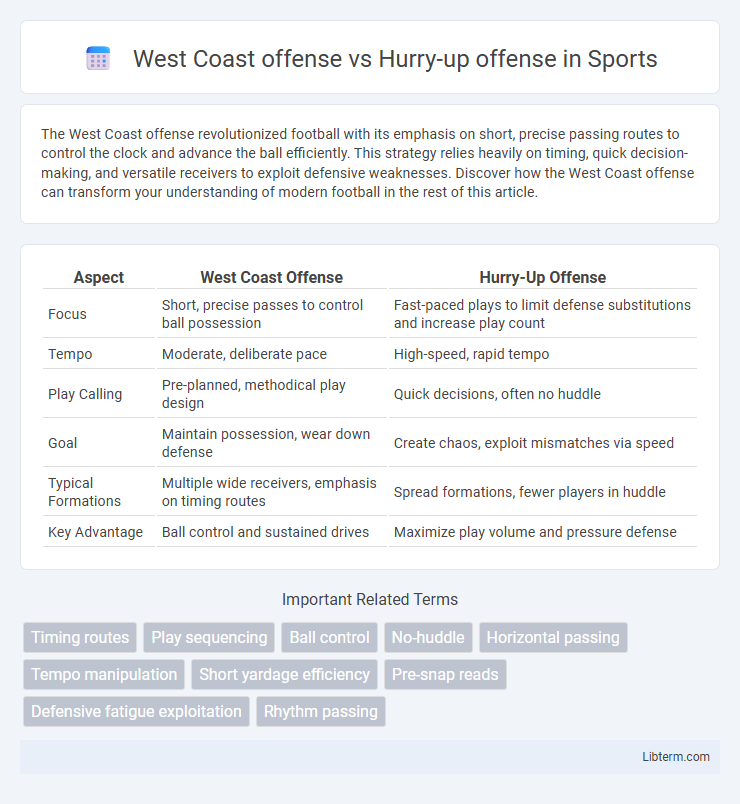The West Coast offense revolutionized football with its emphasis on short, precise passing routes to control the clock and advance the ball efficiently. This strategy relies heavily on timing, quick decision-making, and versatile receivers to exploit defensive weaknesses. Discover how the West Coast offense can transform your understanding of modern football in the rest of this article.
Table of Comparison
| Aspect | West Coast Offense | Hurry-Up Offense |
|---|---|---|
| Focus | Short, precise passes to control ball possession | Fast-paced plays to limit defense substitutions and increase play count |
| Tempo | Moderate, deliberate pace | High-speed, rapid tempo |
| Play Calling | Pre-planned, methodical play design | Quick decisions, often no huddle |
| Goal | Maintain possession, wear down defense | Create chaos, exploit mismatches via speed |
| Typical Formations | Multiple wide receivers, emphasis on timing routes | Spread formations, fewer players in huddle |
| Key Advantage | Ball control and sustained drives | Maximize play volume and pressure defense |
Introduction to Offensive Schemes
The West Coast offense emphasizes short, precise passing routes to control time of possession and create high-percentage completions, relying heavily on timing and synchronization between quarterback and receivers. Hurry-up offense prioritizes rapid play execution with minimal huddling to increase tempo, exploit defensive mismatches, and wear down opponents through continuous pressure. Both schemes leverage distinct strategic principles to optimize offensive efficiency and adaptability on the football field.
Origins of the West Coast Offense
The West Coast offense originated in the 1970s under coach Bill Walsh with the San Francisco 49ers, emphasizing short, precise passes to control the ball and maintain possession. This strategy contrasts with the hurry-up offense, which prioritizes a fast tempo to disrupt defenses and increase the number of plays. While the West Coast offense relies on timing and rhythm, the hurry-up offense focuses on speed and momentum to create defensive mismatches.
Fundamentals of the Hurry-up Offense
The hurry-up offense emphasizes speed, tempo, and minimizing the time between plays to keep the defense unsettled, relying on rapid play calls and quick snaps. Key fundamentals include efficient communication, pre-snap reads, and precise execution of plays without traditional huddles. Mastery of these elements enables the offense to maximize the number of plays and create mismatches, contrasting the West Coast offense's focus on controlled, timing-based plays and short, precise passes.
Key Philosophies: West Coast vs Hurry-up
The West Coast offense emphasizes short, precise passes designed to control the ball and maintain possession, relying heavily on timing and route discipline to methodically advance downfield. Hurry-up offense focuses on rapid play execution with minimal huddles, aiming to exploit defensive fatigue and create mismatches through a high-tempo, fast-paced rhythm. Both offenses utilize different strategies for tempo and decision-making, with West Coast prioritizing efficiency and precision, while hurry-up prioritizes speed and aggressiveness.
Passing Game Strategies Compared
The West Coast offense emphasizes short, precise passing routes designed to control possession and systematically move the ball downfield, relying heavily on timing and receiver route discipline. In contrast, the Hurry-up offense prioritizes rapid play execution with quick, aggressive throws to exploit defensive mismatches and prevent substitutions, increasing the pace to pressure defenders. Both schemes leverage passing attacks differently: West Coast focuses on rhythm and ball control, while Hurry-up aims for tempo and creating chaos in the secondary.
Tempo and Game Management Differences
The West Coast offense emphasizes a controlled tempo with short, precise passes to manage the game clock and sustain long drives, prioritizing ball control and minimizing turnovers. In contrast, the Hurry-up offense accelerates the tempo by reducing time between plays, limiting defensive substitutions to exploit mismatches and maintain constant pressure. This tempo difference impacts game management strategies, with the West Coast offense strategically pacing the game while the Hurry-up offense relies on rapid execution to outpace the defense.
Impact on Player Roles and Responsibilities
The West Coast offense emphasizes precise timing and short, quick passes, requiring quarterbacks to have accurate decision-making skills and receivers to excel in route running and yards after catch. In contrast, the Hurry-up offense accelerates the game's tempo, demanding greater conditioning and adaptability from all players, as it minimizes play-calling breaks and increases on-field shifts. Offensive linemen in the Hurry-up scheme must sustain high stamina for continuous blocking, while skill position players must quickly read defenses and adjust routes in real-time.
Defensive Challenges: Adapting to Each Offense
Defenses face distinct challenges when adapting to the West Coast offense versus the hurry-up offense, as the West Coast offense emphasizes short, precise passes demanding disciplined zone coverage and quick linebacker reactions to counter versatile route combinations. In contrast, the hurry-up offense forces defenses into rapid play-calling decisions and limited substitution options, increasing the risk of miscommunication and fatigue. Effective defensive strategies must prioritize adaptability in coverage assignments and stamina management to counter the fast-paced tempo and complex route trees inherent to both offensive schemes.
Success Stories and Notable Teams
The West Coast offense, popularized by Bill Walsh and led to multiple Super Bowl victories with the San Francisco 49ers during the 1980s and 1990s, is renowned for its precision passing and timing routes. The hurry-up offense, effectively utilized by teams like the Kansas City Chiefs under Andy Reid and Patrick Mahomes, emphasizes a fast pace to exploit defensive mismatches and maintain momentum. Both offensive schemes have produced notable successes, with the West Coast offense revolutionizing NFL passing strategies and the hurry-up offense transforming game tempo and clock management.
Choosing the Right Offense: Factors to Consider
Choosing the right offense depends on team personnel, game tempo preferences, and situational needs. The West Coast offense emphasizes precision passing, timing routes, and ball control, ideal for teams with skilled quarterbacks and reliable receivers. Meanwhile, the hurry-up offense prioritizes speed and minimal huddles to fatigue defenses, benefiting teams with fast players and aggressive game strategies.
West Coast offense Infographic

 libterm.com
libterm.com